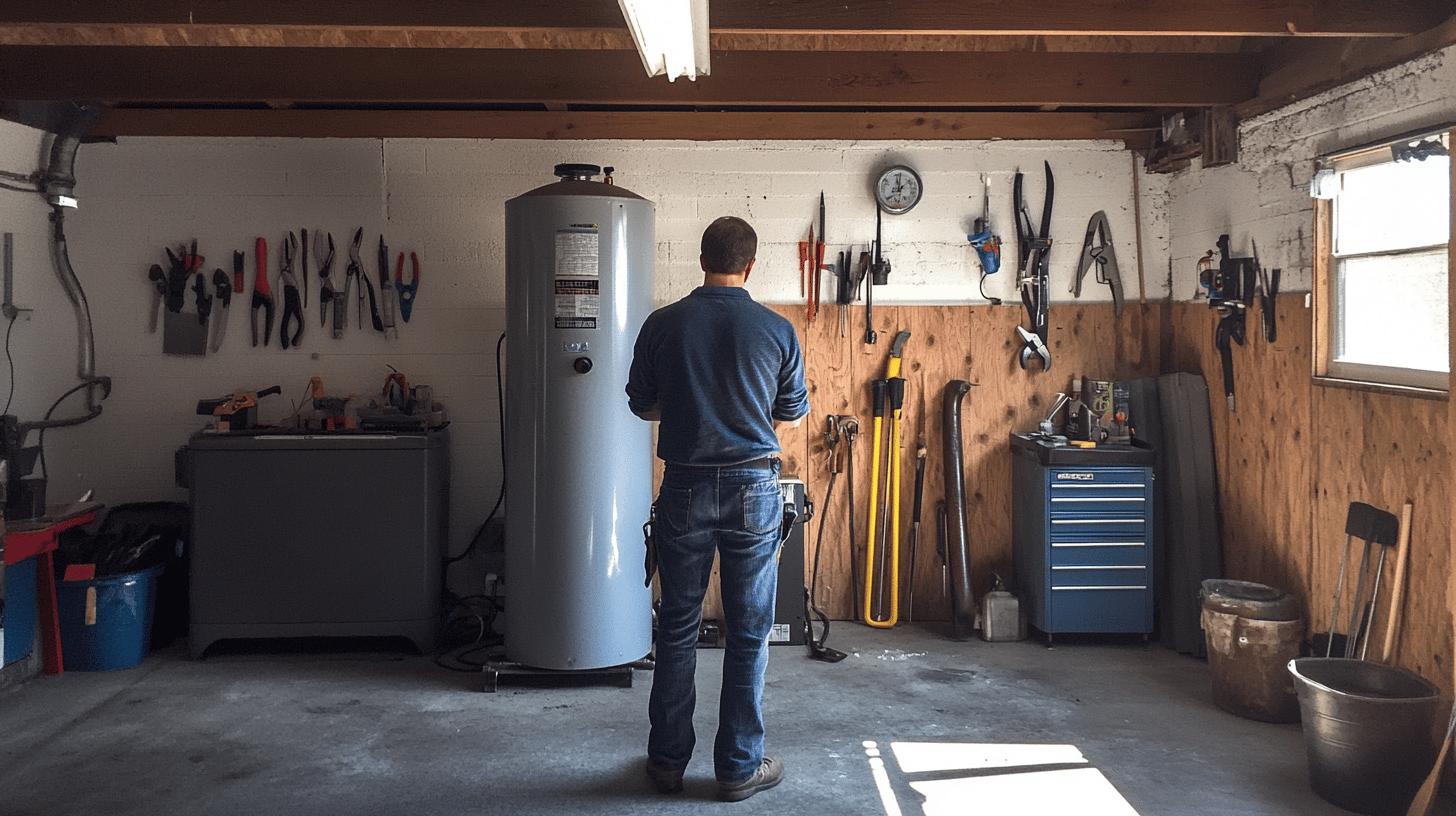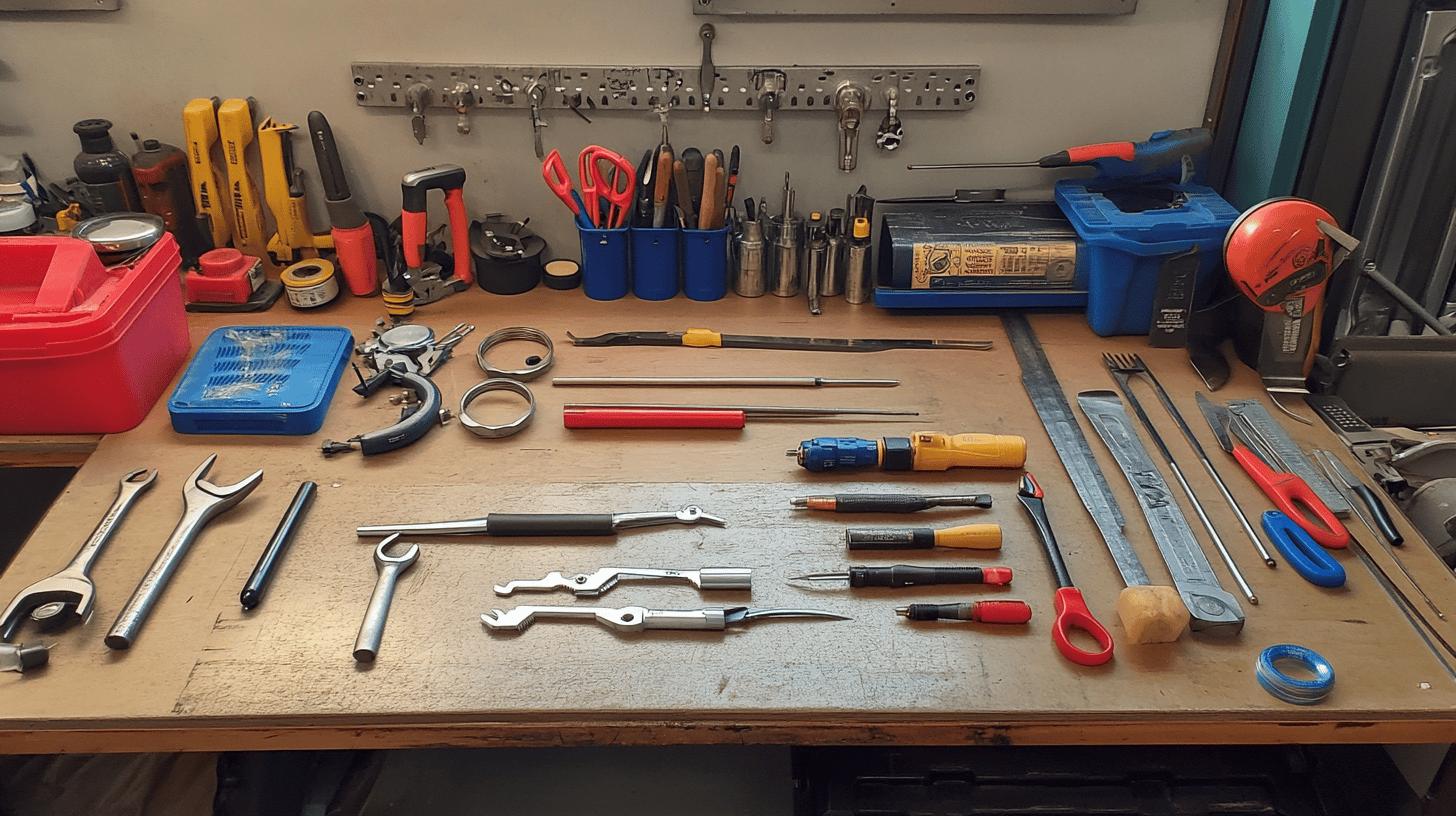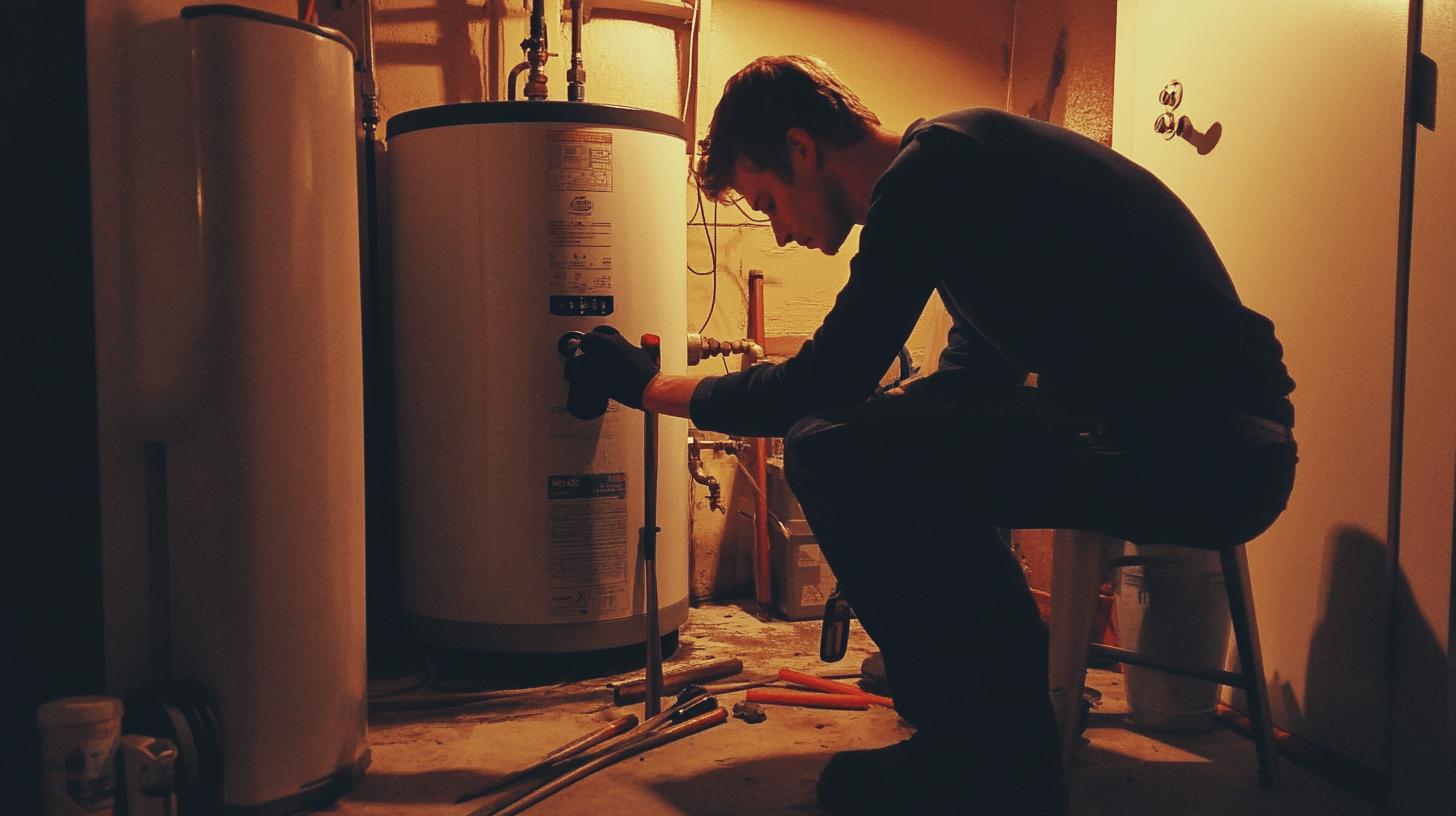TL;DR:
- Lifespan: 12 years (tank), 20 years (tankless).
- Maintenance Benefits: Improves efficiency, saves energy, reduces breakdowns, enhances safety, extends lifespan.
- Tank Maintenance:
- Flush annually
- Inspect anode rod (3-5 years)
- Check for leaks regularly
- Test thermostat annually
- Tankless Maintenance:
- Flush with a descaling kit regularly
- Clean air intake filter every 6 months; replace yearly
- Tools Needed: Garden hose, bucket, socket wrench, screwdrivers, pliers.
- Professional Maintenance: Catches hidden issues, ensures performance.
- Maintenance Schedule: Categorize tasks into annual, monthly, and daily activities for optimal performance and cost savings.
Is your water heater quietly losing years off its lifespan due to neglect? Proper maintenance is key to keeping it efficient and extending its life. Without regular care, tank heaters may only last half of their expected 12 years, while tankless systems might not reach their 20-year potential. By following essential maintenance tips, you can ensure your water heater performs well and lasts longer. Whether you’re into DIY or prefer hiring a professional, having the right knowledge helps you maximize your water heater’s efficiency and longevity.
Understanding Water Heater Maintenance Basics
Regular water heater maintenance is crucial for extending its life and maintaining efficiency. With the right upkeep, tank models can last up to 12 years, and tankless ones can go up to 20 years. Routine care helps prevent minor problems from turning into expensive repairs, ensuring your water heater runs at its best.
- Improved efficiency ensures smooth operation.
- Energy savings come from optimizing water heating processes.
- Reduced breakdowns lower the risk of unexpected failures.
- Safety is enhanced by preventing potential hazards.
- Lifespan is extended for long-term reliability.
Maintenance for tank and tankless water heaters varies. Tank water heaters need regular flushing to remove sediment, along with checking the anode rod and inspecting for leaks to prevent rust and damage. For tankless models, maintaining the heat exchanger and cleaning air intake filters is key. You’ll need a descaling kit for flushing and ensuring proper ventilation. Consistent care helps keep both types running efficiently and extends their lifespan.
Essential Water Heater Maintenance Tasks

Regular maintenance is key to keeping your water heater efficient and long-lasting. Sediment buildup can lead to rust, leaks, and poor performance, making upkeep essential. By performing simple tasks like flushing the tank or descaling a tankless system, you can prevent these issues, ensuring your water heater runs smoothly and efficiently for years to come.
Flushing the Tank
You should flush your water heater tank annually to remove built-up sediment. Sediment can cause corrosion and reduce heating efficiency over time. To do this, turn off the power or gas supply, connect a garden hose to the drain valve, and let the water flow out until it runs clear. This helps keep your water heater functioning optimally.
Inspecting the Anode Rod
The anode rod is essential for preventing tank corrosion. It should be checked every three to five years. If more than half of the rod is corroded, it’s time to replace it. Doing this helps protect the tank lining and significantly extends the water heater’s lifespan.
Checking for Leaks and Rust
Common signs of leaks and rust include water pooling around the tank or rusty water coming from your taps. These are clear indicators of potential leaks or rusting inside the tank. It’s important to address these issues immediately to prevent further damage. Regular inspections can help catch these problems early, saving you from costly repairs.
Testing the Thermostat and Valves
Testing your water heater’s temperature setting is important for both energy efficiency and safety. Keeping the temperature between 120°F and 140°F prevents overheating, which can lead to scalding, while also reducing energy costs. Regularly testing and adjusting the temperature ensures your heater runs efficiently, maintaining a balance between performance, safety, and savings.
| Task | Frequency |
|---|---|
| Flushing the Tank | Annually |
| Inspecting the Anode Rod | Every 3-5 years |
| Checking for Leaks and Rust | Regularly |
| Testing the Thermostat and Valves | Annually |
Professional Water Heater Maintenance Services
Professional inspections are essential because they can catch early signs of problems like sediment buildup, leaks, or corrosion that homeowners might overlook. By identifying these issues early, you ensure the safe and efficient operation of your water heater, providing peace of mind.
Expert knowledge is vital for maintaining both tank and tankless systems. Professionals perform tasks like flushing or descaling with precision, ensuring all components, from the anode rod to the thermostat, are properly inspected and adjusted. This expert care extends the life of your water heater and maximizes its performance.
Yearly maintenance packages save money by bundling regular inspections and preventive tasks at a reduced cost compared to individual service calls. These packages help prevent major breakdowns and extend your water heater’s lifespan, offering long-term savings.
DIY Water Heater Maintenance Tips

Before starting any DIY water heater maintenance, prioritize safety by turning off the power or gas supply. If you’re uncertain about performing a task, it’s wise to consider professional help. Hiring an expert prevents costly mistakes and ensures the work is done safely, giving you peace of mind and protecting your water heater.
Necessary Tools and Equipment
For efficient DIY maintenance, have these tools ready:
- Garden hose
- Bucket
- 1 & 1/16th inch socket
- Half-inch drive socket wrench
- Breaker bar
- Screwdriver
- Needle nose pliers
These tools help you manage most tasks effectively.
Basic Inspection Steps
Routine inspections are essential for spotting potential issues with your water heater early. Check for leaks or corrosion by looking for water pooling around the unit, which indicates a leak. For gas models, examine the venting system for any blockages or damage, as this is crucial for safety. Regularly inspect the anode rod by removing the cover and loosening it with a breaker bar. If the rod is corroded, replace it to prevent rusting of the tank. Keeping up with these checks helps maintain your water heater’s efficiency and extends its lifespan.
Common Troubleshooting Techniques
Addressing minor issues with your water heater promptly can prevent severe problems down the line. If you notice inconsistent water temperatures, check and adjust the thermostat to between 120°F and 140°F. For sediment buildup, flush the tank by attaching a hose to the drain valve and letting water run until it runs clear. Unusual noises often indicate sediment issues, which can also be resolved by flushing the tank. If you detect a foul odor, it might be time to replace the anode rod to eliminate bacteria causing the smell. Taking these steps helps maintain your water heater’s performance and longevity.
Tankless Water Heater Maintenance Guide
Tankless water heaters, while efficient and space-saving, have specific maintenance needs. Since they heat water on demand, regular upkeep is essential to prevent mineral buildup that can impact performance and lifespan. The maintenance mainly focuses on the heat exchanger and ensuring proper airflow.
Flushing the system is crucial for smooth operation. To do this, you’ll need a descaling kit, which typically includes a pump, hoses, and descaling solution. Connect the hoses to the service ports and circulate the descaling solution to clean the heat exchanger and maintain optimal water flow. Regular maintenance helps keep your tankless model running efficiently and extends its life.
- Turn off power and gas.
- Connect kit hoses to service ports.
- Use the pump for solution circulation.
- Rinse with clean water.
Maintaining the air intake filter is essential to prevent dust and debris from entering your tankless water heater. Regularly cleaning these filters ensures unobstructed airflow, which is vital for efficient operation. Inspect the filters every six months and replace them annually, or as needed, to maintain optimal performance. Proper filter maintenance not only enhances efficiency but also extends the lifespan of your water heater.
Scheduling and Frequency of Water Heater Maintenance

an effective maintenance schedule for your water heater can maximize its efficiency and lifespan. Structuring tasks into annual, monthly, and daily activities makes it manageable.
For annual tasks, flush the tank to remove sediment buildup, test the pressure relief valve to ensure safety, replace the anode rod to prevent tank corrosion, and clean the burner assembly for optimal performance.
Monthly tasks include checking for leaks around fittings and connections and verifying thermostat settings to ensure proper temperature control.
Daily tasks involve monitoring for unusual noises or leaks, which could indicate underlying issues.
By following this structured approach, you can keep your water heater running efficiently and extend its life.
- Flush the tank: Annually
- Test the pressure relief valve: Annually
- Replace the anode rod: Every 3-5 years
- Inspect for leaks: Monthly
- Check thermostat settings: Monthly
What’s the deal with the cost benefits of regular maintenance? Sure, it might seem pricey at first, but it actually saves you money in the long run by stopping big repairs or replacements from happening. It helps you avoid those expensive emergency calls and makes your unit last longer, which is great for your wallet. Keeping up with a regular maintenance schedule helps everything run smoothly, cuts down on energy bills, and lowers the chances of things breaking down.
Final Words
Keeping up with regular water heater maintenance really helps your appliance last longer and work better while cutting down on breakdowns. Important tasks like flushing the tank and checking the anode rod are key. Whether you do it yourself or hire a pro, taking care of your water heater is worth it for comfort and reliability.
For tankless systems, you need specific maintenance steps to keep them running well. Setting up a maintenance schedule not only improves performance but also saves you money in the long run. When you make water heater maintenance a priority, you ensure a steady supply of hot water, making your home more comfortable.
FAQ
What maintenance is required for a water heater?
Maintenance for a water heater involves regular flushing to remove sediment, inspecting the anode rod, checking for leaks or rust, and testing the thermostat and valves to ensure efficient operation.
Can I flush my water heater myself?
Yes, you can flush your water heater yourself using a garden hose to remove sediment buildup, improving heater efficiency and lifespan. However, seeking professional guidance is advisable if you’re unsure.
What happens if you never flush your water heater?
If you never flush your water heater, sediment can accumulate, leading to rust, leaks, reduced efficiency, and possible damage to the unit over time.
Do water heaters need to be flushed every year?
Water heaters should be flushed annually to prevent sediment buildup, ensuring optimal efficiency and preventing potential issues that could shorten the unit’s lifespan.
How much does water heater annual maintenance cost?
Water heater annual maintenance typically ranges from $75 to $200, depending on your area and the complexity of the tasks required, such as professional inspection services.
What maintenance is needed for an electric water heater?
Electric water heater maintenance includes inspecting the heating elements, checking electrical connections, testing the thermostat, and flushing to prevent sediment buildup.
How does natural gas water heater maintenance differ?
Natural gas water heater maintenance involves checking the gas lines and connections, inspecting the burner assembly, and ensuring ventilation systems are unobstructed, along with standard maintenance tasks like flushing.
Is DIY water heater maintenance recommended?
DIY maintenance is feasible for basic tasks like visual inspections and flushing the tank. Ensure safety by using proper tools such as a socket wrench, pliers, and a cleaning brush, and consult a professional for complex issues.

